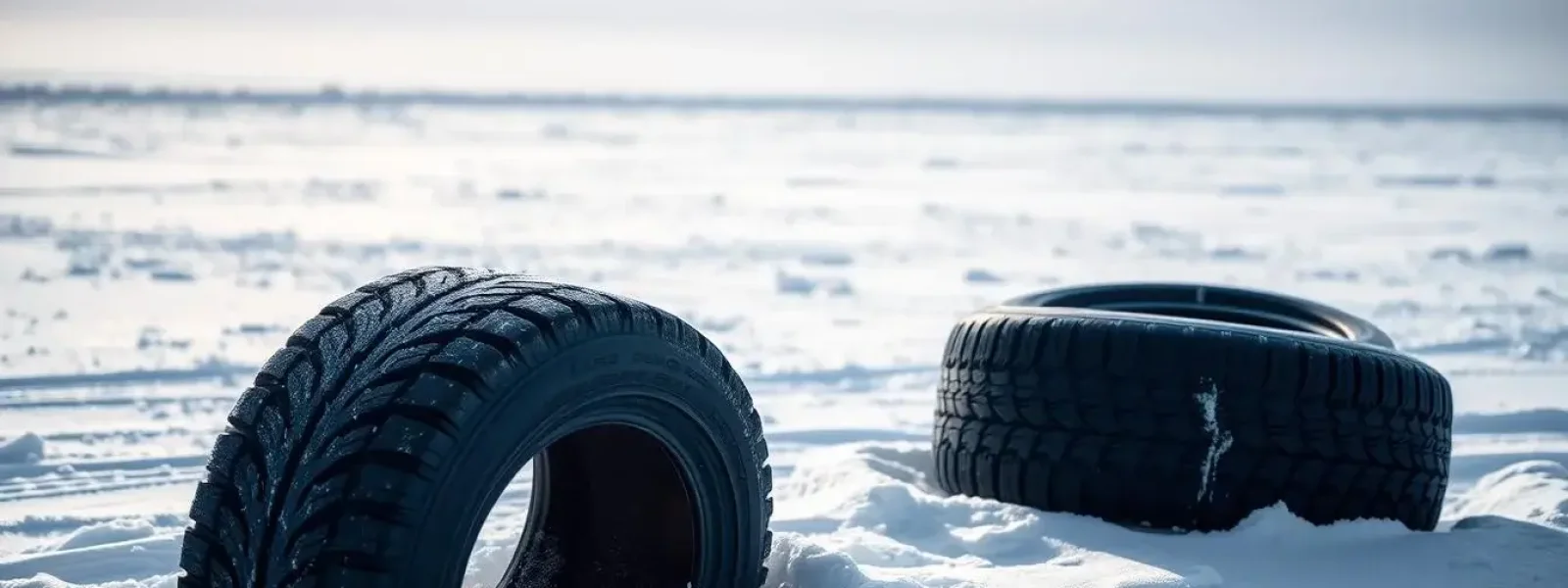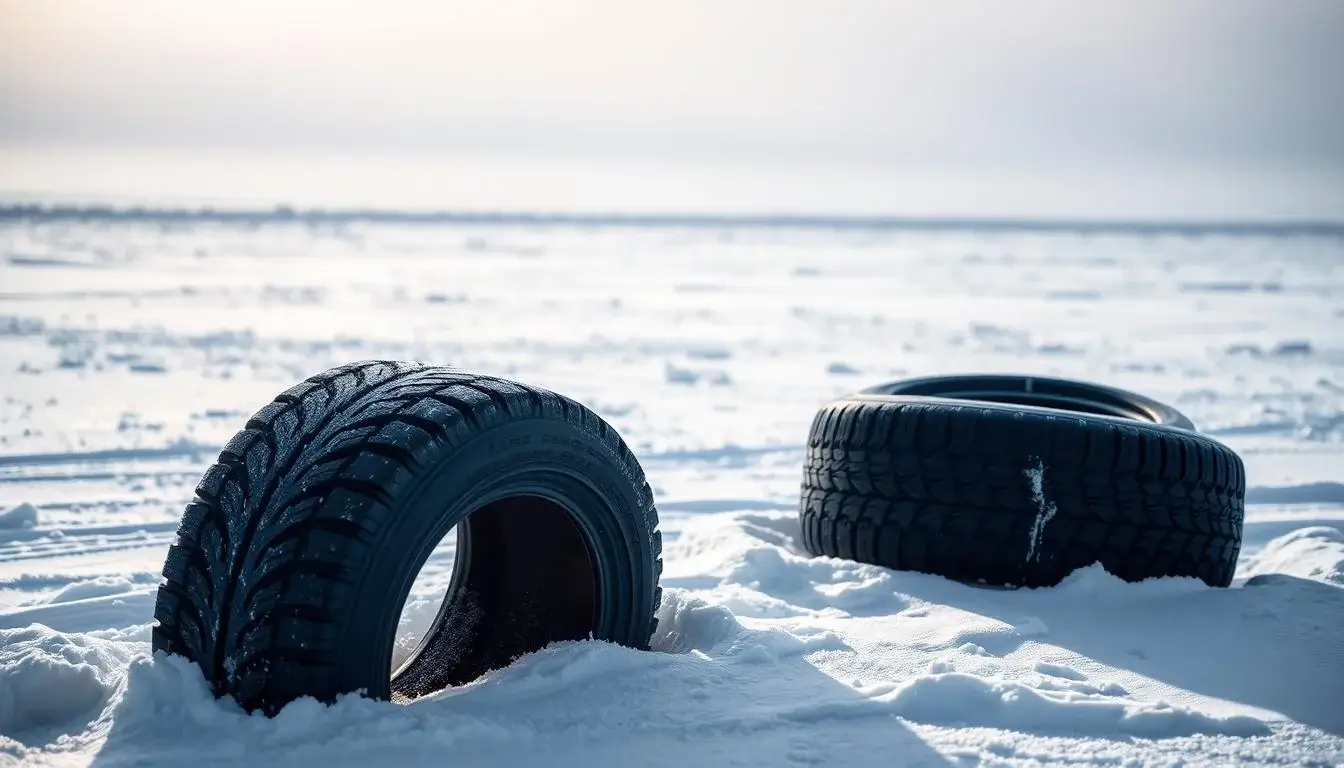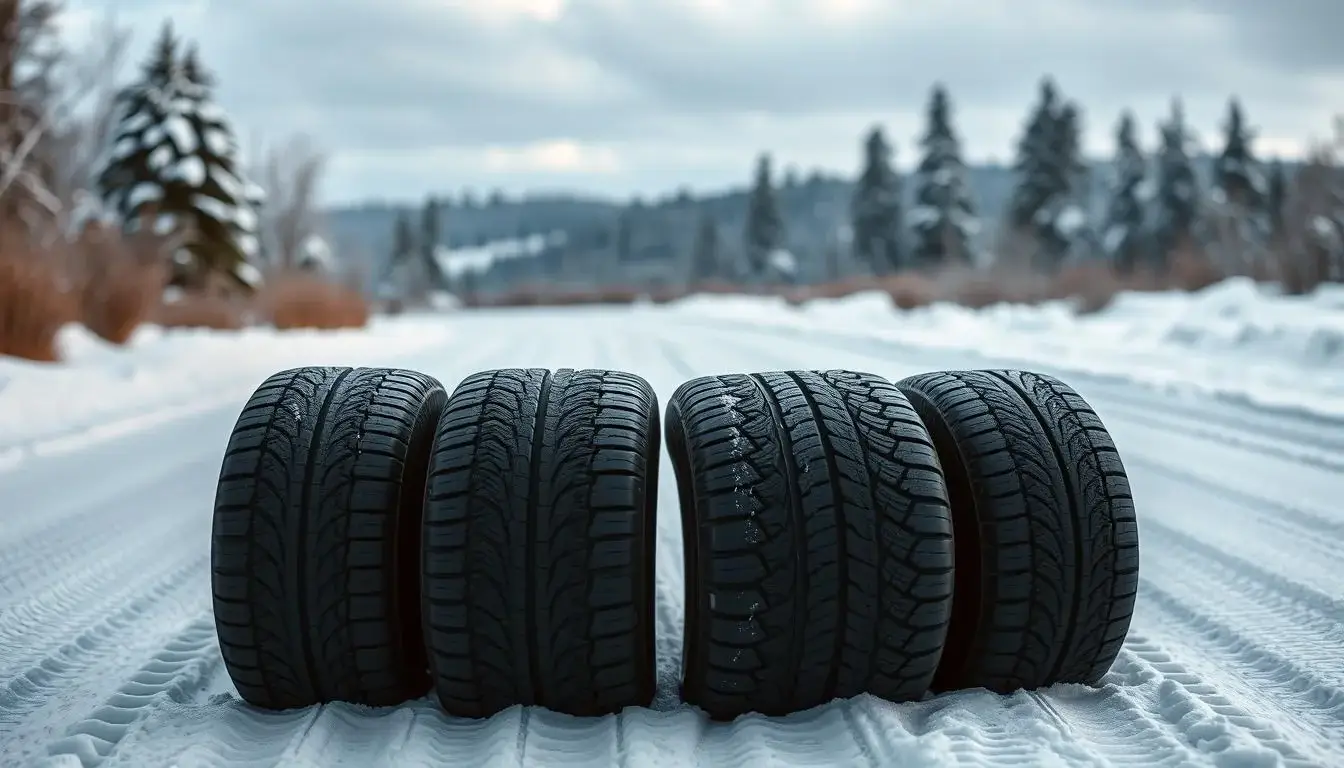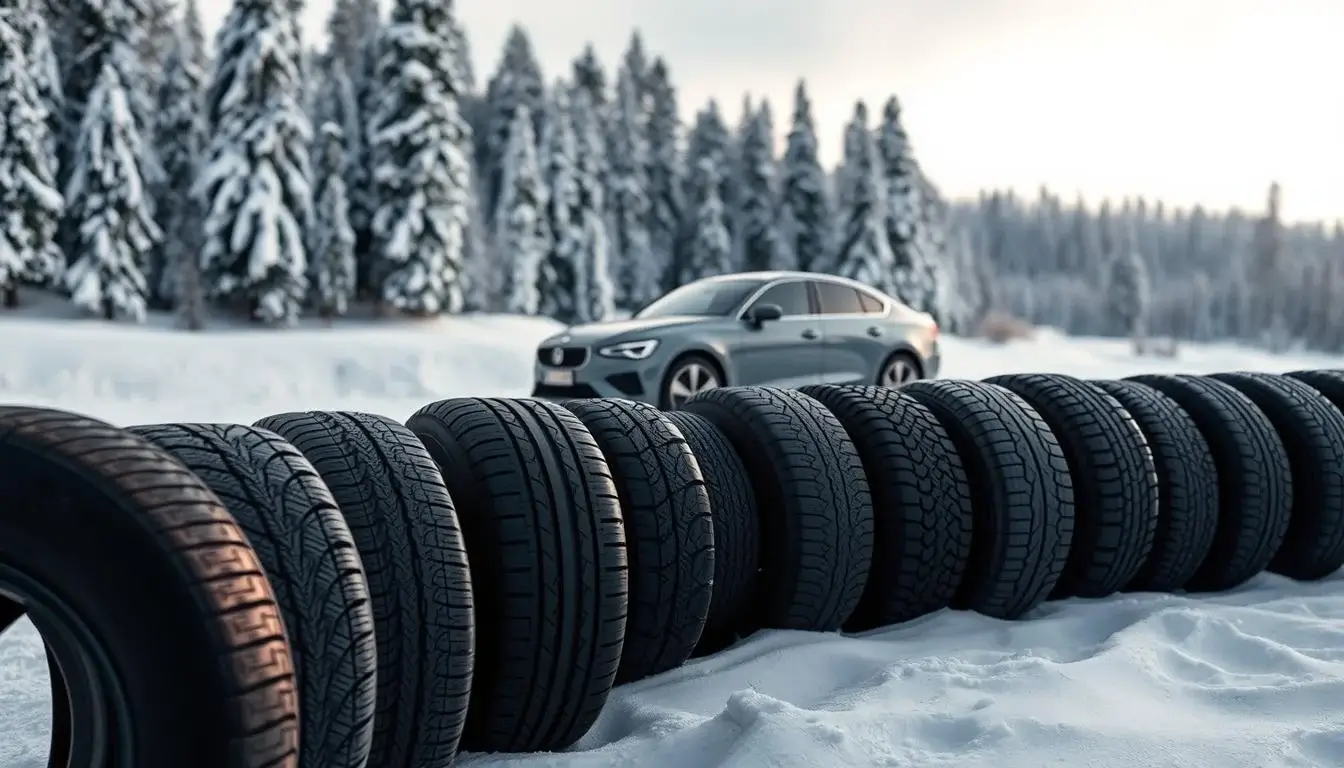Driving in cold weather can be challenging, especially when the roads are covered in snow or ice. Your vehicle’s performance depends heavily on the tires you choose. Winter tires are specifically designed to handle these tough conditions, offering better traction and safety compared to standard tires.
What makes them unique? It’s all about the special rubber compounds and tread patterns. These features allow them to stay flexible in freezing temperatures and grip snowy surfaces effectively. Brands like Bridgestone Blizzak and Michelin X-Ice Snow are excellent examples of tires built for winter performance.
How to Pick Good Winter Tires? Choosing the right set isn’t just about convenience—it’s about keeping you and your loved ones safe. Whether you’re navigating icy roads or driving through a snowstorm, the right tires can make all the difference. Let’s explore what you need to know to make an informed decision.
Key Takeaways
- Winter tires are essential for better traction and safety in cold weather.
- Special rubber compounds keep tires flexible in low temperatures.
- Tread patterns are designed to grip snowy and icy roads effectively.
- Brands like Bridgestone Blizzak and Michelin X-Ice Snow are top choices.
- Choosing the right tires ensures confidence and safety during winter drives.
Understanding Winter Tires: What Sets Them Apart
When temperatures drop, your vehicle’s tires play a critical role in maintaining control on icy roads. Winter tires are engineered with unique features to handle harsh conditions, ensuring your safety and performance. Unlike standard tires, they combine advanced tread designs, specialized rubber compounds, and innovative elements to tackle snow, ice, and slush effectively.
Tread Pattern and Depth for Enhanced Traction
The tread pattern on winter tires is designed to provide maximum grip on slippery surfaces. Deep tread voids help evacuate snow and water, maintaining better contact with the road. Additionally, tiny grooves called sipes enhance traction on ice and slush, giving you confidence in challenging conditions.
Special Rubber Compounds for Cold Weather Flexibility
Winter tires use rubber compounds that remain flexible in freezing temperatures. This flexibility allows them to grip the road more effectively than all-season tires, which can harden in the cold. The result is improved braking and handling, even on icy surfaces.
Unique Design Elements That Improve Safety
Advanced design features, such as reinforced sidewalls and optimized tread blocks, contribute to better stability and control. These elements work together to reduce the risk of skidding and improve overall safety during winter drives.
| Feature | Benefit |
|---|---|
| Deep Tread Voids | Evacuates snow and water for better road contact |
| Sipes | Enhances traction on ice and slush |
| Flexible Rubber | Maintains grip in freezing temperatures |
| Reinforced Sidewalls | Improves stability and control |
Understanding these features helps you make informed decisions about your vehicle’s tires. Proper size and tread depth are also crucial for ensuring optimal performance and safety on winter roads. With the right tires, you can navigate even the most challenging conditions with confidence.
How to Pick Good Winter Tires: Key Factors to Consider
Navigating snowy and icy roads requires more than just skill—it demands the right equipment. Your tires are the foundation of your vehicle’s performance in winter. Understanding the essential features and ratings can help you make a smart choice for your needs.
Essential Features and Winter Tire Ratings
When selecting tires for the season, focus on features like grip, tread design, and rubber compounds. These elements work together to ensure stability and control on snow ice surfaces. Look for tires with deep treads and sipes, which enhance traction and evacuate water effectively.
Ratings are another critical factor. They provide insights into a tire’s performance in specific conditions. For example, a high rating for grip indicates better handling on slippery roads. Always check these ratings to match your driving needs.
The Role of the Three-Peak Mountain Snowflake Symbol
One of the most important indicators on a tire winter is the Three-Peak Mountain Snowflake symbol. This mark signifies that the tire meets rigorous standards for snow and ice traction. It’s a reliable way to ensure your tires are designed for harsh weather conditions.
Investing in tires with this symbol means you’re prioritizing safety and performance. Whether you’re driving through a snowstorm or on icy roads, this certification ensures your tires are up to the task.
By understanding these factors, you can confidently select tires that match your wheel size and driving style. The right tires not only improve your vehicle’s performance but also keep you and your loved ones safe during winter drives.
🚗 Looking for the Best Winter Tires? Get Them Delivered & Installed Easily!
Choosing the right winter tires for your vehicle is essential for safe driving in snow and ice. Amazon offers top-rated winter tires, competitive prices, and even the convenience of professional installation services near you—so you don’t have to worry about finding a service center.
✅ Compare top brands, find the right size, and schedule installation—all in one place!
🔗 Shop Winter Tires + Installation on Amazon
Matching Tire Size and Vehicle Requirements
Your car’s performance in icy conditions depends heavily on the correct tire size. Choosing the right size ensures proper contact with the road, improving traction and handling. Even a slight mismatch can affect your vehicle’s stability, especially in harsh winter weather.
To find the right size, start by checking your vehicle’s owner manual. Manufacturers provide OEM guidelines that specify the ideal tire dimensions for your car. These recommendations are based on extensive testing to ensure safety and reliable performance.
Following OEM Guidelines and Recommended Sizes
Adhering to OEM guidelines is crucial. Using a tire designed specifically for your vehicle ensures optimal handling and safety. For example, a tire with the wrong size or compound can reduce traction and increase stopping distances on icy roads.
Here’s what to consider when verifying tire size:
- Check the owner’s manual for the recommended tire dimensions.
- Compare the tire’s measurements and specifications with OEM guidelines.
- Ensure the load index and speed rating match your vehicle’s requirements.
While all-season tires are versatile, they may not offer the same level of performance as dedicated winter tires. Winter tires are engineered with deeper treads and specialized compounds to handle snow and ice effectively.
By matching the tire size to your vehicle’s requirements, you maintain proper contact, traction, and balanced handling. This ensures a smoother and safer ride, even in the toughest winter conditions.
Timing and When to Switch Tires for Winter Safety
Knowing when to switch your tires can make a significant difference in your safety during colder months. For every driver, safety is a top priority, and the right timing ensures your vehicle is prepared for icy roads.
Recognizing Cold Temperature Cues
When temperatures drop below 45°F, it’s time to act. Summer tires lose their flexibility in the cold, reducing traction and handling. A winter tire designed for cold weather provides superior grip and maintains road contact, even in freezing conditions.
Consulting weather forecasts and local climate conditions can help you determine the best time to make the switch. Delaying this change can compromise your vehicle’s control and increase the risk of accidents.
Planning Seasonal Tire Changes
Switching from summer tires to winter ones isn’t just about safety—it also extends the life of both sets. The right type of tire ensures better performance and reduces wear and tear during seasonal transitions.
Here are some practical tips for planning your tire switch:
- Monitor temperature trends in your region.
- Schedule the change before the first snowfall.
- Store your summer tires properly to preserve their quality.
Proactive planning and awareness of temperature changes are key to maintaining safety and performance throughout the winter season.
Exploring Top Winter Tire Options and Performance Features
Choosing the right winter tires can transform your driving experience in harsh conditions. With so many options available, it’s essential to understand the key features that set top-performing tires apart. From studded designs to advanced rubber compounds, each tire offers unique benefits tailored to specific driving needs.
Studded Versus Studless Winter Tire Designs
Studded tires are designed with metal studs embedded in the tread, providing extra grip on icy surfaces. They’re ideal for areas with severe ice conditions. However, they can be noisy and may not be legal in all regions.
Studless tires, on the other hand, rely on advanced tread patterns and rubber compounds to deliver consistent performance on snow and slush. They’re quieter and more versatile, making them a good choice for most drivers.
Assessing Traction, Grip, and Handling
Traction is a critical factor when evaluating winter tires. Look for deep treads and sipes that enhance grip on slippery surfaces. Tires like the Bridgestone Blizzak are engineered to maintain flexibility in cold temperatures, ensuring better handling and braking.
Handling is equally important. A well-designed tire provides stability and control, even in challenging conditions. This is where brands like Michelin and Goodyear excel, offering models that balance performance and safety.
Comparing Leading Brands and Their Signature Models
When it comes to winter tires, some brands stand out for their innovation and reliability. The Bridgestone Blizzak series is renowned for its superior traction on wet and snowy pavement. Similarly, the Michelin X-Ice Snow offers excellent performance in extreme conditions.
Goodyear’s WinterCommand and Cooper’s Evolution Winter are also top contenders, each with unique features tailored to different driving needs. Whether you prioritize grip, durability, or quiet performance, there’s a tire that fits your requirements.
By evaluating these options, you can make an informed decision that ensures safety and confidence on winter roads.
❄️ Be Winter-Ready – Order Your Tires with Installation Today!
Now that you know how to pick good winter tires, it’s time to get yours changed before the snow arrives! Whether you need premium brands like Michelin, Bridgestone, or Goodyear, or a more budget-friendly option, Amazon makes it easy to find the perfect set. Plus, you can schedule professional installation at a local service center near you for a hassle-free experience!
🚙 Don’t wait for the first snowfall—get your winter tires delivered and installed today!
🔗 Find the Best Winter Tires & Get Them Installed on Amazon
Conclusion
Ensuring your vehicle is ready for icy roads starts with the right set of tires. Understanding tire design, proper sizing, and timely seasonal changes is crucial for safe driving in winter conditions. Snow tires, like those from Bridgestone, dramatically improve traction and reduce stopping distances on snowy, wet, and icy pavement.
Comparing top brands and models based on performance tests ensures you make the best choice. Always opt for a full set of snow tires rather than mixing types for balanced performance. If unsure about switching from summer tires, consult a professional for guidance.
Making an informed decision not only enhances safety but also boosts confidence during harsh winter months. Review your options, schedule a consultation if needed, and equip your vehicle with the best tires for the season.
❄️ Still wondering if winter tires are worth it? Before making your purchase, discover how winter tires improve traction, handling, and braking on snow and ice in our complete guide:
🔗 Do Winter Tires Make a Difference? How to Choose the Best Ones?
FAQ
What makes winter tires different from all-season tires?
Winter tires are designed to stay flexible in severe winter weather, providing grip on snow and ice where all-season tires struggle. They have deeper tread patterns and advanced compounds that allow tires to remain flexible in freezing temperatures, improving traction on snow or slush.
How do I know if a tire is suitable for winter conditions?
Look for rated tires with the Three-Peak Mountain Snowflake (3PMSF) symbol on the sidewall. This certification means the tire meets performance standards for severe snow conditions, offering better handling in harsh winter conditions. Some mud and snow (M+S) tires may also perform well, but winter tires can help significantly more in worst winter conditions.
Should I choose studded or studless winter tires?
- Studded snow tires provide the best traction on deep snow and solid ice, making them ideal if you live in an area with extreme winters. However, they can damage roads and are restricted in some regions.
- Studless winter tires like Bridgestone Blizzak and Nokian Hakkapeliitta offer advanced rubber compounds and siping to provide grip in the snow and on water and slush, without the need for metal studs.
How important is tire size when selecting winter tires?
Choosing the right snow tires means matching the correct size for your vehicle. Using tires on your vehicle that don’t meet OEM recommendations may affect stability and handling. Check your owner’s manual for everything you need to know about tire sizing before buying.
Can I install only two winter tires instead of four?
Installing only two winter tires on the front or rear axle can unbalance the vehicle, leading to poor handling and increased risk of skidding. Winter tires allow for better grip when installed as a set of winter tires, ensuring even traction on all four wheels.
When should I switch to winter tires?
You should get yours changed when temperatures consistently drop below 45°F (7°C). Winter tires can help maintain traction as temperatures drop, even before snow appears. Planning ahead saves you time and ensures you’re prepared for severe winter weather.
What features should I prioritize when buying winter tires?
Look for:
✅ Tires that allow flexibility in cold temperatures
✅ Tires designed to help with braking in snow or slush
✅ Deep snow treads for traction in harsh winter conditions
✅ Water and slush channels to prevent hydroplaning
Are there specific brands known for high-quality winter tires?
Yes! Some of the best snow tires on the market include:
- Bridgestone Blizzak WS90 – Known for severe snow traction
- Michelin X-Ice Snow – Great for long tread life and saving you time
- Nokian Hakkapeliitta – Excellent for deep snow and ice traction
- Goodyear Ultra Grip Winter – Great for installing snow tires on SUVs
Can winter tires be used year-round?
No, winter tires are best used during the winter months. Using them in warm weather can reduce the life of your regular tires, increase wear, and decrease fuel efficiency. Let’s take a look at a better option—switching to summer and all-season tires when winter ends.
How do I extend the life of my winter tires?
✅ Store tires mounted in a cool, dry place
✅ Rotate them every winter for even wear
✅ Use America’s best tire warranty services if available
✅ Avoid driving aggressively in dry conditions



